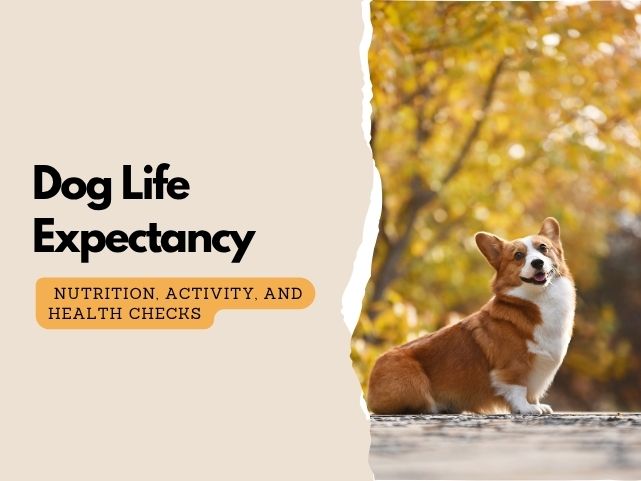How long do dogs live? This is one of the most common questions pet owners ask, and the answer depends on several factors, including breed, size, genetics, and the quality of care provided. In general, a dog’s average life span is between 10 and 13 years, but some canines can surpass this range with optimal nutrition, regular exercise, and consistent veterinary care. Understanding how long do most dogs live is key to providing them with the best care.
What is the Average Life Expectancy of a Dog?
The average lifespan of dogs typically ranges from 10 to 13 years, though some can live even longer depending on their breed and lifestyle. This often leads people to wonder, How long do small dogs live? Small breed dogs tend to have the longest dog age span, often living between 8 to 15 years or more, while larger breeds generally have a shorter typical dog lifespan, sometimes around 7 to 10 years. We often get asked, What is the average life of a dog and it truly varies by many factors.
The average age of dogs also varies by sex and body condition. Female dogs tend to have a slightly higher average life expectancy of a dog compared to males, especially within certain breed sizes.
Maintaining an ideal body condition is crucial, as overweight dogs have a significantly shorter average lifespan than those at a healthy weight.
What Is The Role of Nutrition in a Dog’s Lifespan?

Nutrition is a fundamental factor influencing how long dogs live and the quality of their doggie life. A well-balanced, nutrient-rich diet supports immune function, maintains a healthy body weight, and helps prevent chronic diseases that can shorten a dog’s lifespan..
Scientific studies consistently show that proper nutrition, including diets made with human grade dog food, can extend a dog’s life expectancy and significantly improve their overall health. This directly impacts the life period of a dog.
Why is Balanced Nutrition Important for Longevity?
- Supports Immune Function and Disease Prevention:
A diet rich in essential nutrients, including high-quality protein, omega-3 fatty acids, vitamins, and antioxidants, strengthens the immune system and reduces inflammation. This helps protect dogs from common age-related diseases such as diabetes, heart disease, and arthritis.
- Maintains Ideal Body Condition:
Research shows that dogs live significantly longer when maintaining a lean body condition compared to overweight dogs. For example, a study found that dogs with an ideal body condition score (BCS 3) had a life expectancy of about 13.18 years, whereas overweight dogs (BCS 5)lived roughly 1.5 yearsless on average.
- Prevents Obesity-Related Shortened Lifespan:
Overweight dogs can have areduced lifespan by up to 2.5 yearscompared to dogs at a healthy weight. Proper nutrition helps control calorie intake and promotes a healthy weight, which is critical for longevity.
How Can Tailoring Diets To Different Life Stages And Needs Be Helpful?
Feeding your dog according to its specific life stage and individual needs is essential to support its health and maximise its lifespan.
- Puppies
- Life Stage Duration Feeding Period: Small and medium breeds are typically considered puppies until 12 months, while large and giant breeds may require puppy diets up to 12–18 months.
- Feeding Amount: A puppy weighing 5 to 10 kilograms may require approximately 250 to 400 grams of food per day, divided into 3 to 4 meals. Puppies have higher energy needs than adult dogs due to rapid growth and development. The feeding amount varies based on breed size, age, and growth stage.
- Calories: Puppies require more calories per kilogram of body weight compared to adults due to rapid growth and higher activity levels.
- Nutritional Focus: Diets should be rich in high-quality protein, calcium, and essential fatty acids to support growth and development. Fresh, natural food—not processed—is key for proper nutrient absorption.
- Feeding Tips: Feed 3 to 4 smaller meals a day to help puppies manage energy levels and digestion. Transition gradually to adult food once growth levels off, based on your vet’s guidance.
- Adult Dogs
- Life Stage Duration: Most dogs are considered adults from 12 months up to 6 to 8 years, depending on breed and size.
- Calories: Adult dogs have more stable energy requirements. Needs vary significantly based on activity level, breed, and health.
- Nutritional Focus: Balanced diets that maintain ideal body weight and support daily energy needs are important. Prioritize fresh, natural food over processed options for better long-term health.
- Feeding Tips: Stick to a consistent feeding schedule, and monitor weight regularly. Avoid overfeeding, especially in less active dogs.
- Senior Dogs
- Life Stage Duration Transition: Small breeds are considered seniors at around 11 to 12 years, while large breeds transition earlier, around 6 to 8 years.
- Calories: Senior dogs typically require 20% to 25% fewer calories than adult dogs to prevent obesity due to reduced activity and metabolic rate.
- Feeding Amount: For example, a senior dog weighing 24 to 45 kilograms may require approximately 360 to 640 grams of food per day, depending on their exact weight, activity level, and health condition. Since senior dogs have a slower metabolism and reduced energy needs, it’s important to monitor body condition closely and adjust portions accordingly.
- Nutritional Focus: The best dog food senior dogs is typically lower in calories, fat, sodium, and phosphorus, while being higher in fiber and enriched with joint-supporting nutrients like glucosamine and omega-3 fatty acids. Fresh, natural food—rather than processed—helps manage the effects of aging and supports long-term health.
- Feeding Tips: Senior dogs may benefit from smaller, more frequent meals. Monitor for changes in appetite, mobility, or energy, and adjust the diet accordingly with your vet’s input.
Why Is Exercise Important for Dogs’ Lifespans?

Regular exercise is another key factor in extending your furry friend’s lifespan, directly impacting how long a dog can live. Physical activity helps dogs maintain a healthy weight, strengthens muscles and joints, boosts the immune system, and reduces the risk of chronic diseases. Combined with a nutritious diet that includes healthy pet food, exercise is especially important as dogs age, helping to manage arthritis and maintain mobility.
Dogs typically need 30 to 60 minutes of exercise daily; some breeds may require up to 90 minutes. Activities can include walking, running, swimming, playing fetch, and agility training.
Consistent, intentional exercise promotes a longer doggie life and better overall health.
Older dogs have lower activity levels, but staying active is associated with a longer lifespan relative to breed expectations. Senior dogs average about 23 minutes of intentional exercise daily.
| Benefit | Impact on Dog Life Span and Health |
| Weight management | Prevents obesity, extends life by up to 2.5 years |
| Muscle and joint health | Maintains mobility, delays arthritis symptoms |
| Immune and cognitive function | Reduces infections, delays cognitive decline |
| Chronic disease risk reduction | Lowers the risk of heart disease, diabetes, and cancer |
| Mental well-being | Reduces anxiety, improves quality of life |
How Does Veterinary Care Maximize the Life of a Dog?

Routine veterinary care is essential for extending your dog’s life and maintaining their health. Here’s how regular vet visits contribute to a longer, healthier dog lifespan:
What are the Key Benefits of Regular Veterinary Care?
- Early Detection: Identifies health issues early, allowing for timely and effective treatment.
- Targeted Vaccination Approach: Focuses on only the essential core vaccines. Titer testing can help determine existing immunity, minimizing the risk of unnecessary or frequent re-vaccination that could weaken your dog’s immune system and cause adverse reactions such as allergic responses, inflammation, or long-term immune dysregulation.
- Dental Care: Prevents periodontal disease and related systemic problems. Pairing vet-recommended dental routines with a fresh dog food subscription can further support your dog’s overall health, including better digestion and immune function.
What Preventive Measures Can Be Taken?
- Natural Parasite Prevention: Focus on prevention through a clean, fresh diet. Dogs fed balanced, natural meals tend to be more resilient and less attractive to parasites. Avoid routine use of harsh chemical preventatives, which may carry risks such as neurological side effects, including seizures.
- Health Screenings: Monitors organ function and helps detect chronic diseases early, allowing for timely intervention.
- Weight and Nutrition Advice: Supports a healthy body condition and helps prevent obesity, a major factor in the reduced average life expectancy of a dog.. Incorporating items like dog dental treatscan also promote oral health while contributing to a balanced, low-calorie diet.
How Can We Manage Aging in Dogs?
- Senior Care: Adjusts diet, exercise, and treatments for age-related conditions like arthritis and cognitive decline.
- Supplements & Medications: Supports joint health and overall wellness.
What Lifestyle Guidance is Available for Dod Owners?
- Exercise Plans: Tailored to your dog’s breed and health.
- Behavioral Support: Addresses anxiety and stress for better well-being.
- Owner Education: Empowers you to spot early illness signs and provide proper care.
Conclusion:
Giving your dog the best chance at a long, healthy doggie life starts with everyday choices with balanced nutrition, regular exercise, and consistent veterinary care. These factors work together to prevent disease, support mental and physical well-being, and increase your dog’s lifespan. No matter your dog’s breed or age, the right care can make a lasting difference.
At Soluky, we’re dedicated to helping you make the right choices every step of the way. From personalized diet plans to expert health guidance, Soluky Pet puts your pet’s wellness first.
Start your dog’s journey to a longer, happier life and explore Soluky Pet today.
FAQs:
How long do small dogs live?
Small breeds typically have a longer average age than larger breeds, often outliving larger breeds by several years. For example, Chihuahuas and Toy Poodles can live up to 16 years or more.
What is the average life expectancy of a dog by breed?
Each breed has a typical dog lifespan. Researching your dog’s breed can provide insights into their expected lifespan and help you anticipate health needs.
What factors shorten or lengthen a dog’s life period?
Genetics, environment, quality of food, and lifestyle choices all impact the average lifespan of a dog. Dogs with healthy diets, regular exercise, and proactive vet care tend to have a longer dog age span.
What is the maximum dog life expectancy?
Most dogs live between 8 and 15 years, depending on their breed, size, and overall health. While this range gives a good idea of the average life of a dog, some exceptional dogs have lived beyond 20 years, particularly when given optimal care, including regular veterinary checkups, a low-stress lifestyle, and a fresh, natural diet, which has been commonly noted among the longest-living dogs.

 You Might Also Like
You Might Also Like

